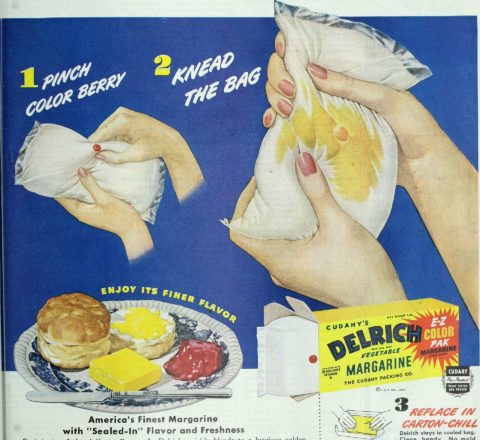
When margarine attacks!
One of those alarmist emails has been circulating with fake news about margarine. A friend sent it to me and asked if there was any truth in it. There is a little bit, but not much! It is horribly misleading, and has even been debunked by Snopes. I’ll go over the email’s claims one by one.
The claims
- Margarine was originally manufactured to fatten turkeys
When it killed the turkeys, the people who had put all the money into the research wanted a payback so they put their heads together to figure out what to do with this product to get their money back. It was a white substance with no food appeal so they added the yellow coloring and sold it to people to use in place of butter.
Nonsense! It absolutely was not manufactured to fatten turkeys. It was invented in France in 1869 in response to Napoleon III’s offer of a prize to anyone who could produce a viable, low cost substitute for butter, intended for use by the army and the lower classes. Hippolyte Mège Mouriès concocted a mixture of beef fat, salt water, milk, and margaric acid. He called it oleomargarine. The beef fat was eventually replaced by vegetable oils. Butter is made from the butterfat in milk; modern margarine is made from refined vegetable oil and water, and may contain milk.
It was originally marketed without yellow coloring, and people readily bought the white version. I remember an incident from my childhood. I ate dinner at a friend’s house where they served a “white butter.” I was impressed by the novelty, and I thought it tasted better than yellow butter. I went home and asked my Mom to buy it!
At one point, they sold the white version along with a package of food coloring that could be mixed with it to make it look more like butter. Eventually they began doing the mixing themselves prior to marketing.

I can’t imagine where the claim about killing turkeys came from. That appears to be pure fantasy.
Both have the same amount of calories
Yep! 100 calories per tablespoon for both butter and margarine. You can also buy “light butter” and margarine with 50 calories per tablespoon each.
Butter is slightly higher in saturated fats at 8 grams; compared to 5 grams for margarine
Wrong on both counts. Butter contains 7 grams of saturated fat per tablespoonful. Margarine’s fat content varies by brand: I Can’t Believe It’s Not Butter Light contains 1 gram; most other brands contain 1.5 grams. Snopes provides a table comparing various brands.
Eating margarine can increase heart disease in women by 53% over eating the same amount of butter
They say this was according to a “recent Harvard Medical Study.” I couldn’t find any such study. I did find a 1997 epidemiologic study suggesting that trans fats in margarine might slightly increase the risk of heart disease in men. A large prospective 2017 study subsequently found that substituting soft tub margarine for stick margarine or butter may be associated with a lower risk of heart attack.
The dietary advice about fats and heart disease has evolved over time. At first the concern was about cholesterol, which is present in butter but not margarine. (Two brands of margarine (Take Control and Benecol) not only contain no cholesterol but block the absorption of cholesterol.) Then hydrogenated oils in margarine became a cause for concern. Gradually the emphasis changed from cholesterol to total fats, then to saturated fats, and eventually trans fats were identified as the worst offender.
The chart on the Snopes website shows that the total fat in butter is 11 grams per tablespoonful compared to 5-10 grams for various brands of margarine. Butter contains no polyunsaturated fats; margarine contains between 2.5-4.5 grams. Butter contains no monounsaturated fats; margarine contains 1.5-4.5 grams. Current standard dietary advice is to choose a margarine with no trans fats and the least amount of saturated fat.
Eating butter increases the absorption of many other nutrients in other foods
Where did this claim come from? I found no evidence to support it. Perhaps they were thinking about the fact that some vitamins are fat-soluble, but that would apply to margarine as well as to butter.
Butter has many nutritional benefits where margarine has a few and only because they are added!
Butter does have more vitamin content than margarine, but the difference would be negligible for most people eating a varied diet.
Butter tastes much better than margarine and it can enhance the flavors of other foods
Most people think that butter tastes better, but they can’t always tell the difference, especially when it is combined with other food or used in baking.
Butter has been around for centuries where margarine has been around for less than 100 years
What kind of math is that? I count well over a hundred years from 1869 to 2018.
Margarine is very high in trans fatty acids
Many brands contain no trans fats at all, especially the liquid and tub margarines.
Margarine triples risk of coronary heart disease
There is no evidence for this claim. As I mentioned above, it may actually decrease the risk.
Margarine increases total and bad cholesterol while lowering good cholesterol
Margarine will only increase total and LDL (bad) cholesterol if it is high in saturated fats. And butter is higher in saturated fats than margarine. Anyway, the impact of diet on LDL and HDL (good cholesterol) levels is small.
Margarine increases the risk of cancers up to five times
No, it doesn’t! There isn’t a shred of evidence for that claim.
Margarine lowers quality of breast milk
Trans fats, maybe. Not the margarines that don’t contain trans fats.
Margarine decreases immune response and decreases insulin response
Trans fats may do that. Margarines that don’t contain trans fats don’t do that.
Margarine is but ONE MOLECULE away from being PLASTIC and shares 27 ingredients with PAINT
This is absurd and was obviously made up by someone with no understanding of chemistry. It doesn’t even make sense. Margarine contains several different molecules. Plastics are polymers and completely unrelated to anything in margarine. Paint doesn’t contain any of the ingredients in margarine. I can’t even imagine where this claim came from unless perhaps some ignoramus confused the quality of plasticity with the molecular composition of plastics.
If they were thinking of atoms rather than molecules, that’s even worse. Water (H2O) and hydrogen peroxide (H2O2) only differ by one atom, but drinking water is necessary for life while drinking hydrogen peroxide is a very bad idea. The properties of molecules have little to do with their chemical composition.
Would you melt your Tupperware and spread that on your toast?
Good grief, no! What a ridiculous analogy! But I would spread my toast with margarine.
Margarine does not rot or attract flies because it has no nutritional value
You wanna bet? Margarine has nutritional value. It is food, like butter is food. I can’t believe that flies would reject it. You can do your own experiment.
Conclusion: both butter and margarine are OK
There’s no need to avoid either, although there are reasons to use them in moderation. I use both. I buy a tub margarine that has half the calories of butter, only 1.5 grams of saturated fat per tablespoon, and no trans fats. It is convenient and spreadable, and I can justify using more of it than I would of butter, since it has half the calories. I also buy butter and use it for situations where I think I might be able to taste a difference; I only spread it on my toast when I have remembered to take the butter out of the refrigerator and let it warm up to where it is spreadable.
The lesson to be learned: information in alarmist emails is likely to be fake news, or what Kellyanne Conway might call “alternative facts.” The information must be verified elsewhere. At the very least, do your friends the courtesy of checking Snopes.com before you forward the email to them.
Just for fun, here’s another use of margarine:

